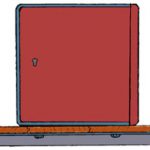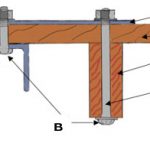Before a club member can purchase their first handgun, they must have a suitable safe to store it in. These tips will help you meet SSPC’s minimum requirements in order to get your Form 3 signed off.

SECURING FIREARMS
BEFORE YOU BUY A SAFE!
Before the club will endorse the purchase of your first (and any subsequent) handgun, you must provide a completed form 3 to declare your safe keeping facilities meet Schedule 4 of the Firearms Act 1996.
TIPS ON BUYING & MOUNTING A SAFE:
These tips will help you meet Schedule 4 of the Firearms Act 1996 which sets out the minimum requirements in order to get your Form 3 signed off. We have also included recommendations of ‘Best Practice’ standards. We have done this to give you direction of how you can best secure your firearms and as such, secure your sport.
WHERE SHOULD YOU INSTALL YOUR SAFE?
Victoria Police will not approve a safe mounted in a garage or shed that is not part of the house. Plan to mount it inside the house. One of the reasons Victoria Police don’t approve garages or Sheds is the likely availability of power tools, crowbars, etc. in such locations.
Best Practice: The preferred location for a safe is in the floor of a built-in cupboard so that it is not visible from windows and not obvious to visitors. Don’t leave things outside the safe that may give a clue to its contents (an empty Smith & Wesson box on top of the safe is likely to attract the interest of the casual housebreaker.
DO YOU NEED AN ALARM SYSTEM?
When Victoria Police calculate the total number of firearms at the property, they include long-arms as well as handguns. If more than 15 firearms are stored on the premises then an intruder alarm must be fitted.
Best Practice: We strongly recommend you consider the installation of an alarm system for any number of firearms. Think like a housebreaker: what would you do to get into the safe or tear it off its hinges? Would you take the time required to remove or break into a safe, while the Alarm was going off?
GENERAL SAFE CHARACTERISTICS:
The safe must be of steel construction which is of a thickness that is not easily penetrable and which when any firearm is stored in it, is locked.
Best Practice: A safe that is rated by the manufacturer as meeting Category H. However a safe that is constructed of structural grade 250 mild steel conforming to AS3679 and is of not less than 6mm in thickness is absolute best practice. Plan ahead, as the rules always get tougher in any review of the act. Generally, external hinges are considered too easy to attack, but if they are backed up by an additional internal mechanism (e.g. hinge pins, sliding bolts, internal door retention brackets), they are generally of a high standard. Don’t buy a ‘fireproof document safe’: these are built to withstand fire but have relatively thin layers of steel and insulating material.
SAFE LOCKS:
The club and Victoria Police do not approve of cheap combination locks. In some instances, where a key is used in conjunction, they may be approved.
Best Practice: The preference is for the ‘Ross’ type lock with at least five levers, see illustration. Remember, if you are the only licensed person in the house then you must be the only person with access to the key!
INSTALLATION OF YOUR SAFE:
Schedule 4 of the Firearms Act 1996 states that if the safe weighs less than 150 kilograms when it is empty, then it must be bolted to the structure of the premises where the firearm is authorised to be kept
CONCRETE FLOOR INSTALLATION:
Use four Dynabolts or Loxins with a minimum shaft diameter of 9.5mm are recommended. Insurance companies recommend a good layer of liquid nails to help stick the safe to the concrete floor.
TYPICAL WOODEN FLOOR INSTALLATION:
Two strips of flat bar or angle iron running from floor joist to floor joist to prevent use of a jigsaw to remove floor and safe.These must be at least as thick as the safe walls. Bolts in four places with 9.5mm minimum bolts; 12mm is better. If you can bolt through a bearer as well, do so! Even a strap over the bearer gives added security. If you must leave the nuts under the floor, burr the threads so that they cannot be removed, or weld the nuts to the plate or Angle Iron as extra security.

WOODEN FLOOR INSTALLATION LEGEND
A. If floor joist mounting is not possible, use heavy angle iron or steel plate
B. Cup head coach bolts, heads under floor, nuts inside safe!
C. Be generous with angle iron. Extend floor joist to floor joist
D. Floor of safe
E. Floor boards
F. Floor joist
G. Ideal mounting is through floor joist

Safekeeping of firearms and ammunition while Being Carried or Used
Victoria Police have guidance on the Safekeeping of your firearms and ammunition whilst being carried or used and while being transported in Vehicles.
You can find that guidance on their page by selecting the following link; http://www.police.vic.gov.au/content.asp?Document_ID=36210
Safekeeping of firearms and ammunition while Being Carried or Used
Section 126 of the Firearms Act 1996 states: A person who is carrying or using a category C or D longarm or a General Category Handgun must:
1. Ensure that the firearm is carried and used in a manner that is secure and is not dangerous; and
2. Must take reasonable precautions to ensure that the firearm is not lost or stolen. Guidance on the Victoria Police Website (which is what they expect and will deem ‘reasonable’) states:
Safekeeping of firearms when being transported in vehicles
The information below has been developed to provide firearm licence holders a guide on how firearms and ammunition should be transported in most circumstances.
While the guidelines are aimed at minimising risk, licence holders should consider all factors that may contribute to the firearms being transported in a manner that is not secure or in a way that presents a danger.
Police will treat each individual case on its merits and there may be circumstances where the guidelines are followed but criminal charges are still warranted if the overall security of the firearms are compromised due to aggravated circumstances.
For example if a firearm is securely stored in the trunk but the owner of the vehicle is driving the vehicle while intoxicated or speeding they might be considered to have compromised the security of the firearm.
Additionally circumstances such as this may indicate that the firearm owner may not really understand the responsibilities required for proper firearm ownership
In most circumstances firearms should be transported in the following manner:
![]() Firearms should be transported in a padded cover or hard case, unloaded and preferably rendered inoperable;
Firearms should be transported in a padded cover or hard case, unloaded and preferably rendered inoperable;
![]() While being transported, firearms and ammunition should be kept out of sight and stored in separate receptacles that are either secured to the inside of you vehicle or in a lockable component of your vehicle; and
While being transported, firearms and ammunition should be kept out of sight and stored in separate receptacles that are either secured to the inside of you vehicle or in a lockable component of your vehicle; and
![]() Cartridge ammunition should be stored separately from the firearms in a part of the vehicle not readily accessible by an unauthorised person.
Cartridge ammunition should be stored separately from the firearms in a part of the vehicle not readily accessible by an unauthorised person.
![]() A lockable glove box would suffice provided the key to the glove box is kept securely by the holder of the firearm licence and cannot be accessed by persons unauthorised to possess ammunition or firearms.
A lockable glove box would suffice provided the key to the glove box is kept securely by the holder of the firearm licence and cannot be accessed by persons unauthorised to possess ammunition or firearms.
![]() Licence holders should exercise a common sense approach to storage when transporting their firearms and be mindful of all of their obligations.
Licence holders should exercise a common sense approach to storage when transporting their firearms and be mindful of all of their obligations.
Club Recommendations: Ultimately,
it is your responsibility to follow the law. As a club, we have provided some recommendations below to help you meet best practice and meet the Victoria Police guidelines.
Remember: You are at the mercy of the interpretation of the individual Police Officer that decides that you are taking ‘reasonable precautions’ to ensure that the firearm is not lost or stolen. Their idea of what is ‘reasonable precautions’ can widely differ from yours.
Recommendation – “Handgun:
![]() Have your Handgun(s) stored in a locked box that is secured to your Vehicle by a cable.
Have your Handgun(s) stored in a locked box that is secured to your Vehicle by a cable.
![]() Transport your locked box in the boot so it is out of sight. If you have a station wagon or 4WD, then make sure the box is out of sight.
Transport your locked box in the boot so it is out of sight. If you have a station wagon or 4WD, then make sure the box is out of sight.
Recommendation – Magazines/Speedloaders:
![]() Make sure all magazines/Speedloaders are unloaded! A loaded magazine constitutes a loaded firearm.
Make sure all magazines/Speedloaders are unloaded! A loaded magazine constitutes a loaded firearm.
Recommendation – Ammunition:
![]() Store your ammunition in a separate locked box that is secured to the vehicle by a cable.
Store your ammunition in a separate locked box that is secured to the vehicle by a cable.
![]() Transport your ammunition box in the boot so it is out of sight. If you have a station wagon or 4WD, then make sure the box is out of sight.
Transport your ammunition box in the boot so it is out of sight. If you have a station wagon or 4WD, then make sure the box is out of sight.
Recommendation – Drinking Alcohol:
![]() If the Police Officer deems you to be intoxicated, they can deem you to have compromised the security of the firearm. This only says intoxicated. It does not give a blood alcohol level, so it is left up to the Police Officer to decide. That means that even one alcoholic drink can put you at risk is you are in charge of and transporting a firearm.
If the Police Officer deems you to be intoxicated, they can deem you to have compromised the security of the firearm. This only says intoxicated. It does not give a blood alcohol level, so it is left up to the Police Officer to decide. That means that even one alcoholic drink can put you at risk is you are in charge of and transporting a firearm.
Recommendation – Speeding:
![]() Speeding is outlined that it can be treated the same as intoxication and the Police Officer can deem that you have compromised the security of the firearm.
Speeding is outlined that it can be treated the same as intoxication and the Police Officer can deem that you have compromised the security of the firearm.
Moral of the Story:
Don’t drink or Speed while transporting Firearm(s)
Recommendation – Leaving your Car unattended with firearm(s) and/or ammunition in it:
Do not leave your vehicle unattended while firearms and/or ammunition are in it. This means don’t go shopping etc and leave your firearms and/or ammunition in the car. If you leave it unattended then you can be deemed to have compromised the security of the firearm.
